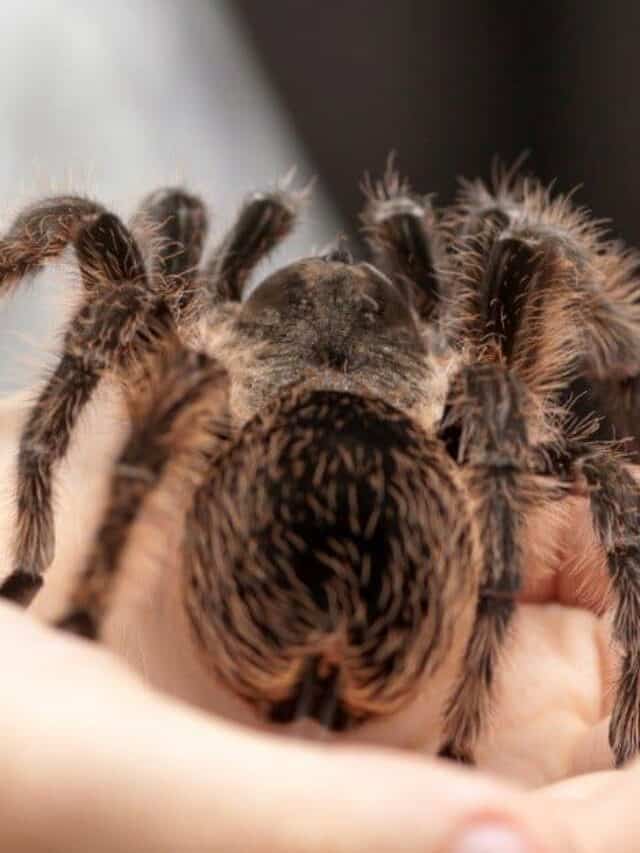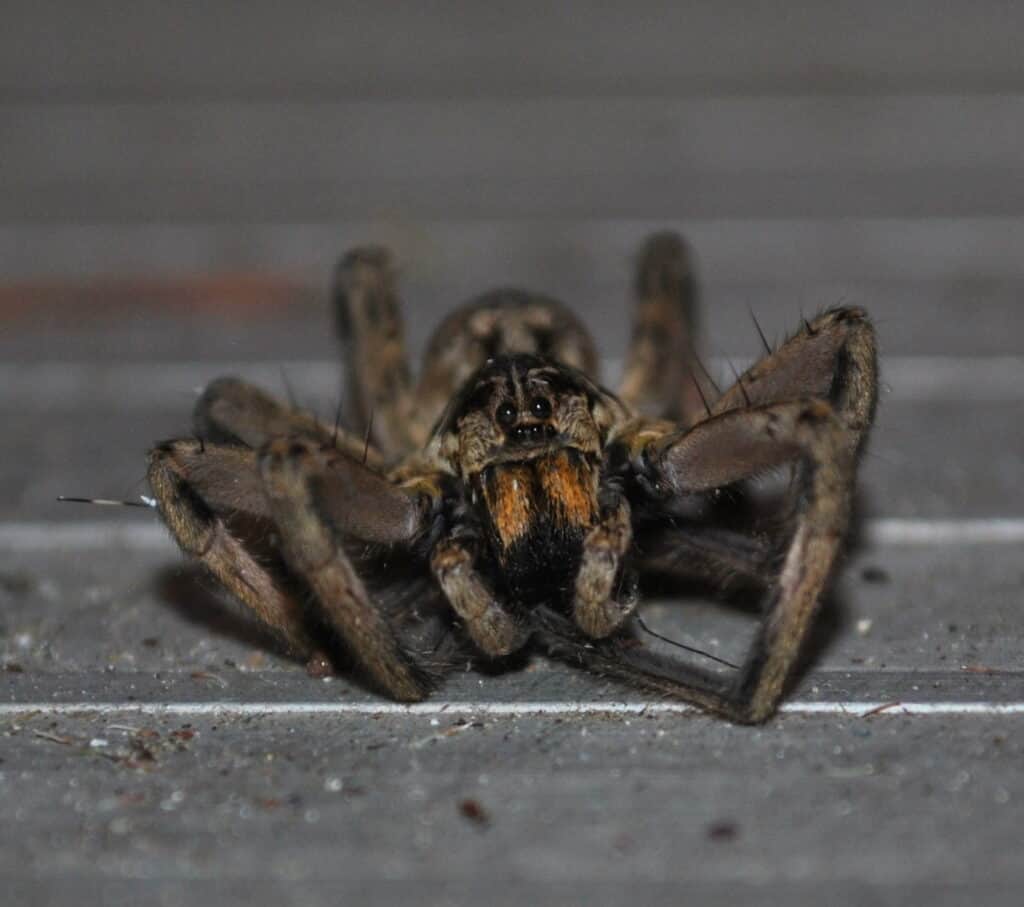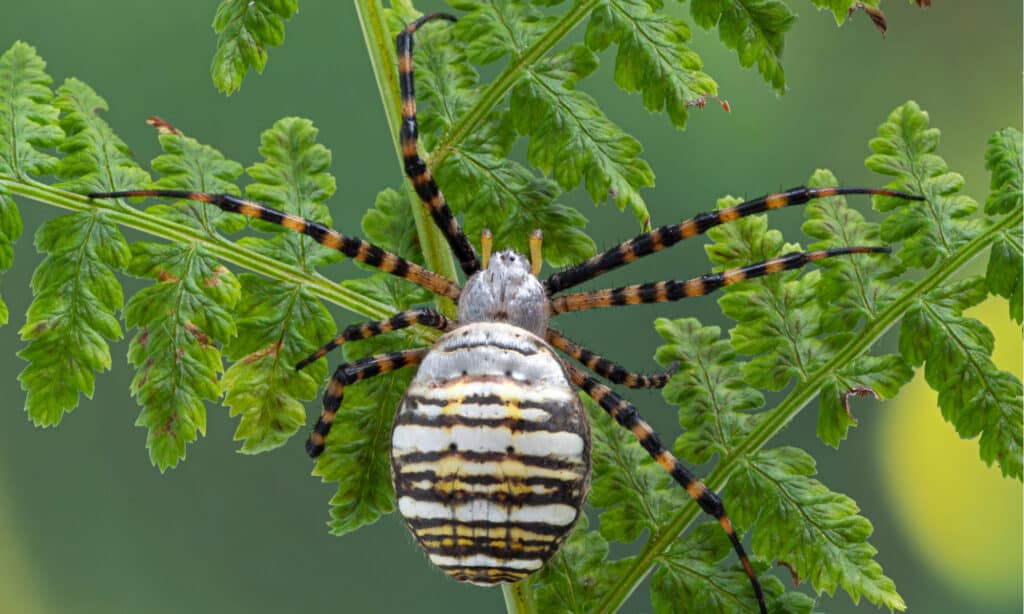There are at least 28 different species of spiders in Rocky Mountain state – including these 3 biggest spiders in Colorado. Spiders can come in a variety of shapes and sizes. Some are small enough that you can barely see them. Others, like those on this list, are sometimes larger than birds!
Although spiders, especially larger ones, can be intimidating, they’re usually more afraid of us than we are of them. Plus, the majority of spiders in the United States are harmless to humans. Even those that can bite us often don’t have side effects other than mild pain or swelling. In fact, out of thousands of species across the country, there are only around a dozen of medically significant species in the United States, none of which are on this list.
Are you ready to meet the three biggest spiders in Colorado? Let’s dive in!

Tarantulas

Tarantulas are more common in the southern parts of Colorado.
©iStock.com/waldru
There are three different species of tarantula found in Colorado: the brown tarantula (Aphonopelma coloradanum), the Colorado chocolate brown tarantula (Aphonopelma echinum), and the Oklahoma brown (Aphonopelma hentzi). Although these species have a slight variation in size between themselves, they’re all top contenders for being some of the biggest spiders in Colorado.
The Oklahoma brown tarantula is the best documented of the three species. Also known as the Texas brown tarantula or the Missouri tarantula, this is one of the most common species of tarantula found in the southern region of the United States. They can grow to weigh as much as 3 ounces, larger than some species of hawks! As for their legs, they can grow to be as long as four inches. That’s the same as a credit card.
Although their place as one of the biggest spiders in Colorado can make them intimidating, the tarantulas of Colorado are virtually harmless. They’re docile and unlikely to respond with aggression. On the chance that you are bitten by a tarantula in Colorado, it’s unlikely to be medically significant unless you experience an allergic reaction or suffer an infection at the bite site.
Wolf Spider

Wolf spiders are some of the biggest spiders in Colorado.
©Aaron Carlson / CC BY-SA 2.0, Flickr – License
There are nearly 3,000 species of wolf spiders found across the world, and they’re a common sight in Colorado. Unlike other types of spiders, the wolf spider doesn’t spin webs. Instead, these top predators will actually chase down their prey, just like their canine namesake!
The most common species of wolf spider in Colorado is the Carolina wolf spider (Hogna carolinensis). It also happens to be the biggest species of wolf spider in all of North America. Females, which are larger than males, can grow to be around 1.3 inches. That’s just a little bit bigger than your thumb. Some are large enough that they can be mistaken for tarantulas.
Although the wolf spider packs a powerful bite with paralyzing venom, it isn’t a huge threat to humans. A bite from one of these large spiders may lead to some localized numbness and a risk for infection. However, other than this, complications are rare.
Despite their place as one of the biggest spiders in Colorado, the wolf spider has a variety of predators. These can range from scorpions to coyotes!
Banded Garden Spider

Between their large size, bright colors, and webs, it can be hard to miss the banded garden spider.
©Ernie Cooper/Shutterstock.com
The banded garden spider (Argiope trifasciata) is just a few millimeters smaller than the wolf spider. At just under an inch long, it is the smallest spider on this list so far but still one of the biggest spiders in Colorado.
Also known as the banded orb-weaving spider, you’ve most likely seen a banded garden spider around. These are the bright yellow and black spiders that like to weave intricate webs in your garden and around the outside of your home. Due to the way they sit, with their legs together in pairs, they often appear to have four legs rather than eight.
Their role as one of the biggest spiders in Colorado isn’t the most interesting thing about them, however. Instead, it’s their web. One of the reasons that the garden spider is so notable is because of its highly visible webs. Scientists still aren’t entirely sure why these spiders build such large, noticeable webs. In fact, it’s even been shown that they may catch fewer insects in their webs compared to other spiders. However, at the same time, their webs are less likely to be destroyed by passing animals, such as by birds flying through them.
There are several types of orb weaver spiders in Colorado, but the banded is by far the largest.
What Other Types of Spiders Live in Colorado?

People have nicknamed the hobo spider the aggressive house spider for a good reason.
©iStock.com/randimal
Colorado is home to a wide variety of spiders, many of which can be found near homes and businesses. The most commonly seen species in the state are the black widow, brown recluse, and hobo spiders.
The black widow is easily identifiable due to its black and red coloring. The female black widow spider is much more venomous than the male and can be found in dark places such as sheds, basements, and woodpiles.
The brown recluse is another common species in Colorado. It is usually light to dark brown in color and has a distinctive violin-shaped marking on its back. This species is shy and reclusive, often found in dark places such as attics, garages, and closets.
The hobo spider is slightly smaller than the other two species and is usually gray or brown in color. This spider is often found in grassy areas and near the foundations of buildings. It builds webs in dark places such as basements and crawlspaces.
What are the Environmental Benefits of Having Spiders Around?

Some spiders help spread pollen, while others aerate the soil or eat insects.
©Joyce LCY/Shutterstock.com
Spiders can be beneficial to the environment in many ways. They are an important part of the food chain, as they feed on a wide variety of insects, including those that can cause harm to crops. By controlling the number of insects, spiders also help to reduce the need for chemical pesticides, which can be damaging to local ecosystems.
Spiders also play an important role in pollination. As they move around, they help to spread pollen between plants, allowing them to reproduce. This helps to maintain a healthy balance in the environment.
Spiders can also help to keep other pests in check. By preying on them, spiders can help to reduce the population of some of the more damaging pests, such as mosquitoes or ticks.
In addition, spiders can play an important role in the health of our soil. As they traverse the ground, they help to break up the soil and increase airflow, allowing vital nutrients to reach the roots of plants. This helps to maintain a healthy balance of minerals in the soil, as well as helping to reduce compaction.
Summary of The 3 Biggest Spiders in Colorado
| Rank | Spider | Size |
|---|---|---|
| 1 | Tarantulas | Up to 4 Inches |
| 2 | Wolf Spider | Up to 1.3 Inches |
| 3 | Banded Garden Spider | Almost 1 Inch |
The photo featured at the top of this post is © texas brown tarantula/Shutterstock.com
Thank you for reading! Have some feedback for us? Contact the AZ Animals editorial team.






